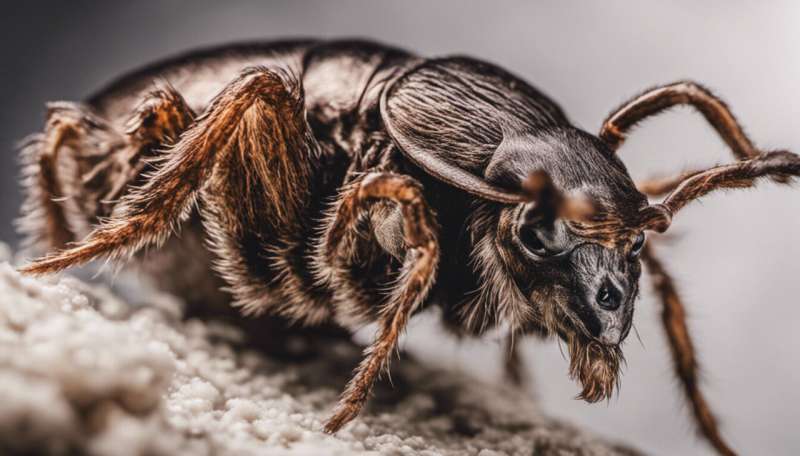
Climate change is already having, and will continue to have, a significant effect on global health. This is likely to be greatest in rural poorer populations in sub-Saharan Africa. However, richer countries, such as the UK, will also probably be on the receiving end of emerging infectious disease threats as the country warms.
Infections that are mainly found in the tropics are on the move to new locations. Dengue, a virus transmitted by mosquitoes, is becoming more widely reported in European countries, particularly in some parts of Italy and France. The West Nile virus, which is also spread by mosquitoes, has been common across many states in the US, with typically more than 1,000 cases reported each year.
Another virus shifting to new locations is the Crimean-Congo hemorrhagic fever virus (CCHFV), which is transmitted by ticks. Most cases occur in Africa or Asia, but cases have been reported in several European countries, including Spain, Turkey, Greece, Russia and Ukraine, with recent media reports warning we might see the virus arrive in the UK.
So what is CCHFV, and should we be worried? Let’s take a look.
There are approximately 15,000 cases of CCHFV a year, globally. CCHFV is a serious pathogen—typically between 10-40% of people who contract the virus will die from it.
As the name suggests, CCHFV is part of a group of diseases known as viral hemorrhagic fevers. These are described as causing “severe multi-system syndrome”, meaning multiple organ systems in the body are affected. These infections can also be accompanied by severe bleeding. Other viruses in this group include Ebola, Marburg, dengue, and Rift Valley fever virus.
CCHFV is transmitted by a tick species called the Hyalomma tick. The virus was first identified in the Crimean Peninsula in 1944, with an outbreak in the Congo in 1956 resulting in the modern-day name. To avoid stigma, the linking of pathogen names to the site of the first known outbreaks is no longer practiced.
A tick bite is the most common way to contract CCHFV. Though transmission has also occurred after needlestick injuries or from infected blood, meaning there is some risk to healthcare workers.
But there is little sustained transmission between humans, with outbreaks typically relying on the presence of an infected tick. Hyalomma ticks can be found on a range of animals, including livestock and rabbits. Most animals appear to be able to carry the tick and the virus without becoming unwell.
In people infected with CCHFV, symptoms typically start with fever, muscle ache or dizziness, and can rapidly progress within a few days to kidney deterioration or sudden liver failure.

CCHFV is recognized by the World Health Organization (WHO) as a virus where there has been limited research but where the pathogen is considered to be a high threat.
There is no vaccine available, nor any established antiviral treatment. However, ribavirin, a medicine used to treat other viruses such as hepatitis C, has shown some promise.
Should we be worried?
Within the UK, there have so far only been small numbers of imported cases, where people have contracted the virus while traveling in high-risk areas.
There is ongoing research and surveillance in areas such as marshlands, where ticks and mosquitoes are caught and studied to see if there are any new or evolving threats. The Hyalomma tick is not currently established in the UK, and so the threat, for now, is very low.
Still, there are many other types of ticks in the UK, including those responsible for causing Lyme disease, which are usually found on vegetation. They cannot walk or fly, so the public health advice for protecting against tick bites includes avoiding brushing against vegetation when out for walks, carrying out regular tick checks and using repellents.
In areas where CCHFV is a higher risk, such as during or after an outbreak, hygienic storage of meat is thought to be important, and restrictions around the transport of animals may be introduced.
There is concern from the WHO and other health experts about the global spread of this Hyalomma tick. The wide range of animals on which the tick is found means there is potential for it to become endemic in new communities. The tick has also been detected in long-range migratory birds, and was found in 2018 in Sweden for the first time.
Viral hemorrhagic fevers like CCHFV can cause severe illness and death in some people who become infected. Also, localized outbreaks can have other consequences for poor farming communities, such as the slaughter of their cattle and subsequent loss of trade.
There is unlikely to be a significant number of cases of CCHFV in the UK at any point soon. However, as globalization increases and climate change continues to alter patterns of disease, it’s plausible that the virus might pose a sustained threat in the future.
Provided by
The Conversation
This article is republished from The Conversation under a Creative Commons license. Read the original article.
Source: Read Full Article
